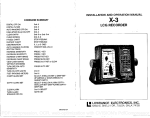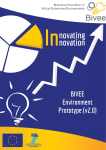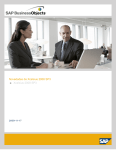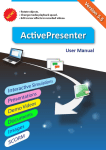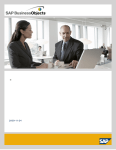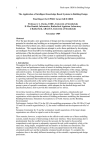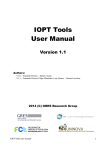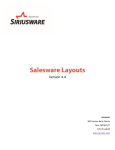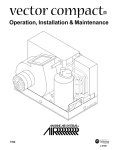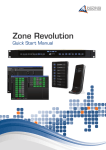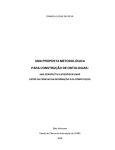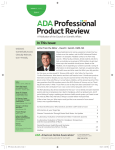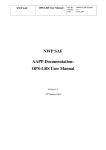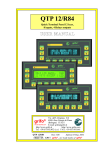Download ANNEX 1: ATHOS USER MANUAL
Transcript
ONT2 – Ontology based support to Enterprise Interoperability – ATHOS manual ANNEX 1: ATHOS USER MANUAL Activity B6 - Training © 2005-2006 The ATHENA Consortium. ONT2 – Ontology based support to Enterprise Interoperability – ATHOS manual Table of contents 1. EXECUTIVE SUMMARY ........................................................................................................4 1.1 RESTRICTION OF USE...................................................................................................................4 1.2 ACCESS TO THE SYSTEM ...............................................................................................................4 1.3 DISCLAIMER .................................................................................................................................4 2. INTRODUCTION ....................................................................................................................4 2.1 DEFINITION OF AN ONTOLOGY...................................................................................................6 2.2 THE ATHOS METAMODEL ............................................................................................................6 2.2.1 OPAL meta-concepts ................................................................................................................6 2.2.2 Athos concepts templates.............................................................................................................7 2.2.3 Identification Section..................................................................................................................8 2.2.4 Structural Section......................................................................................................................8 2.2.5 Specific Section ........................................................................................................................9 2.3 ATHOS CONCEPTS REFERENCES AND USE...................................................................................11 2.3.1 Concepts list...........................................................................................................................11 2.3.2 Pending list............................................................................................................................11 3. THE ATHOS SYSTEM...........................................................................................................13 3.1 GENERALITY .............................................................................................................................13 3.2 ATHOS USER CATEGORIES .........................................................................................................13 3.3 ONTOLOGY USERS AND GROUP ORGANISATION .........................................................................14 3.4 ATHOS LOGIN............................................................................................................................15 3.5 ATHOS LOGOUT.........................................................................................................................16 4. THE ATHOS INTERFACE DESCRIPTION .....................................................................17 4.1 THE MENU BAR .........................................................................................................................17 4.2 THE NAVIGATION BAR ..............................................................................................................18 4.3 THE CONCEPT LIST PANEL.........................................................................................................20 4.4 THE IDENTIFICATION SECTION PANEL ......................................................................................21 4.5 THE STRUCTURAL SECTION PANEL ............................................................................................22 © 2005-2006 The ATHENA Consortium. ONT2 – Ontology based support to Enterprise Interoperability – ATHOS manual 5. ONTOLOGY USER FUNCTIONS.......................................................................................23 5.1 DISPLAY A CONCEPT .................................................................................................................23 5.1.1 The Identification Section..........................................................................................................24 5.1.2 The Structural Section .............................................................................................................25 5.1.3 The Specific Section .................................................................................................................26 5.2 DISPLAY A CONCEPT SPECIALISATION HIERARCHIES ..................................................................27 5.3 DISPLAY A CONCEPT DECOMPOSITION HIERARCHIES ................................................................28 5.4 THE SEARCH FUNCTION ............................................................................................................29 5.4.1 The search function activation ....................................................................................................29 5.5 THE GLOSSARY MODE FUNCTION ..............................................................................................31 5.5.1 Glossary mode........................................................................................................................31 5.5.2 Export glossary function...........................................................................................................32 5.6 PRINT A CONCEPT .....................................................................................................................33 6. THE ONTOLOGY MASTER FUNCTIONS.......................................................................34 6.1 CREATE A NEW CONCEPT ..........................................................................................................35 6.1.1 Input of the Identification Section ...............................................................................................35 6.1.2 Input of the Structural Section ...................................................................................................37 6.1.3 Input of the Specific Section.......................................................................................................40 6.2 EXAMPLE OF CREATION OF A NEW CONCEPT ............................................................................43 6.3 EDITING AN EXISTING CONCEPT ...............................................................................................47 6.4 DELETING AN EXISTING CONCEPT ............................................................................................49 6.5 PENDING TERMS MANAGEMENTT ..............................................................................................50 7. REFERENCES ........................................................................................................................51 ACKNOWLEDGEMENT...............................................................................................................52 © 2005-2006 The ATHENA Consortium. ONT2 – Ontology based support to Enterprise Interoperability – ATHOS manual 1. Executive summary This document represents the ATHena Ontology System (Athos) User manual. It is intended to provide guidance to potential users and Knowledge Engineers that are in charge of the creation and of the maintenance of specific Reference Ontologies, to be used in activities, connected to the Projects, that are related to the development of Advanced Technologies for Interoperability of Heterogeneous Enterprise Networks and their Application, under the European project ATHENA. Athos is a software tool developed by LEKS (Laboratory for Enterprise Knowledge and Systems), at IASI-CNR, for the definition and management of domain ontologies. 1.1 Restriction of use Athos has been developed and released as a deliverable of the European ATHENA project A3, Knowledge Support and Semantic Mediation Solutions. The Athos tool is released for use by the authorized Athena project members for purposes linked to the Athena project objectives; any other use outside this project should be authorized by the Athena Project management. 1.2 Access to the system Athos functionalities can be accessed, via a common web browser, at the address http://lekspub.iasi.cnr.it/Athos. The browser must be enabled to accept cookies. Potential users must request in advance access rights to the Athos Administration Center by e-mail. to: [email protected]. 1.3 Disclaimer Athos is released as a prototype software within an advanced research program; LEKS, IASI-CNR cannot be held responsible for loss of data or information through potential malfunctions of the released software, even if great care has been taken in Athos development and testing. LEKS, IASI-CNR welcomes any information and suggestions that may improve the system. Improvements and communications can be addressed to: [email protected]. 2. Introduction © 2005-2006 The ATHENA Consortium. ONT2 – Ontology based support to Enterprise Interoperability – ATHOS manual The current document is the user guide of the Athos (Athena Ontology System), a software tool developed by LEKS at IASI-CNR, for the definition and management of domain ontologies. The current document is composed of the following chapters: • the current Chapter 2 – Introduction: provides a brief introduction to the concepts of an Ontology, followed by the description of the modelling notions used by Athos and of the structure of the Athos user interface; • Chapter 3 - Athos System: gives an outline of the Athos system, the different user profiles and the description of the Login-Logout procedures that allow the access to the selected Athos functionalities; • Chapter 4 - Athos Interface Description: describes the functionalities and the panels that constitute a common structure of interaction and are available to all Athos profiles; • Chapter 5 – Ontology User Functions: describes the functions and the panels that are intended for the normal User Profile; • Chapter 6 - Ontology Master Functions: describes the functions and the panels that are reserved for the Ontology Master Profile; • An Appendix that lists useful references to concepts related to Ontologies. © 2005-2006 The ATHENA Consortium. ONT2 – Ontology based support to Enterprise Interoperability – ATHOS manual 2.1 Definition of an Ontology An ontology represents a shared understanding of some domain of interest [Usch96]. It entails some sort of world view with respect to a given domain. It contains a set of concepts (e.g., representing entities, attributes, processes), together with their definitions and their inter-relationships; this is also referred to as a conceptualisation. In other words, an ontology is an explicit, agreed specification about a shared conceptualisation. An ontology may have different degrees of formality but, necessarily, it includes a vocabulary of terms with their meaning (definitions) and their relationships. According to [IDEF5], an ontology is a domain vocabulary containing a set of precise definitions, or axioms, that: • provide the meaning of the terms, • enable a consistent interpretation of the terms defined in the vocabulary. 2.2 The Athos metamodel A metamodel is a set of modelling notions, definitions and rules that allows the definition of a conceptual model of a given domain. Therefore the metamodel allows one to specify which are the information to be provided and the rules to be followed during the definition of concepts that constitute an ontology. The metamodel adopted in the Athos system is based on a subset of the OPAL methodology. For sake of conciseness, such a methodology will not be recalled here entirely; only a brief description of the OPAL modelling notions will be given in the following sections. A complete description of OPAL is the object of the Part 2 of this deliverable. 2.2.1 OPAL meta-concepts According to OPAL (Object, Process, Actor modeling Language), an ontology is constructed by defining a set of concepts and establishing semantic relations among them. OPAL supplies a set of predefined concept categories (referred to as metaconcepts) and semantic relations that form the OPAL framework. The definition of a domain concept takes place by filling a concept template (conceived according to a frame-slot-facet approach), supplying first the OPAL category it belongs to, then the filling of the specified slots. © 2005-2006 The ATHENA Consortium. ONT2 – Ontology based support to Enterprise Interoperability – ATHOS manual The OPAL categories, also referred to as kinds, are classified as Primary and Complementary, according to the following prospect: Primary Kinds: ●Actor : aimed at modelling any relevant entity of the domain that is able to activate or perform a process. (e.g. Buyer, Supplier); ●Object: aimed at modelling a passive entity, on which a process operates, typically to modify its state. (e.g., Purchase Order, Invoice); ●Process: aimed at modelling an activity that is performed by an actor to achieve a given goal. (e.g. Issuing Purchase Order, Sending Request for Quotation). Complementary kinds: • Atomic Attribute (AA): represents an elementary information, such as “street name”; • Complex Attribute (CA): is defined as an aggregation of lower level CA and/or Atomic Attributes; • Message(Msg): describes the interaction between processes; • Business Object Document (BOD): represents the content of a message. Other complementary meta-concepts, based on conditionals (e.g., State, Goal), are used to complete the definition of Primary Concepts. The OPAL concepts are connected by conceptual relations. 2.2.2 Athos concepts templates The OPAL meta-model is used in the user interface of Athos to guide the Knowledge Engineer in the construction of an Ontology. In OPAL, a concept is specified according to a traditional Frame-SlotFacet modeling paradigm. In particular, there is a frame structure (template) for each concept category. OPAL templates are used in the interface of Athos to allow the user to introduce domain concepts in the ontology. © 2005-2006 The ATHENA Consortium. ONT2 – Ontology based support to Enterprise Interoperability – ATHOS manual . To show its structure an example of “template for Business Concepts” is shown in Fig.1. Fig. 1 – Athos Template structure: a Business Object Document example An Athos template is organised in three sections: • Identification Section; • Structural Section; • Specific Section. The first two sections are the same for all the three templates, while the third section is designed specifically for each template, with the aim to represent domain specific links and dependencies 2.2.3 Identification Section It contains an intuitive and textual description of the concept, plus a number of meta-information fields: • Label: the preferred term to refer the conceptDescription: natural language description • XMLTag: a tag that can be used to refer to the concept in a XML documentTerminology: synonyms of the preferred termsAuthor: who defined the concept • References: documental sources used for the concept definition 2.2.4 Structural Section It contains: • Attributes: they are classified as: • Atomic Attributes [AA]: elementary data properties; © 2005-2006 The ATHENA Consortium. ONT2 – Ontology based support to Enterprise Interoperability – ATHOS manual • • • Complex Attribute [CA]: structured data properties. Hierarchies: • ISA: concepts specialization (e.g., an invoice is a business_document) • Part of: concepts decomposition (e.g., a department is part of an enterprise) Relatedness: domain specific relationship between concepts (e.g., the invoice is related to the customer) 2.2.5 Specific Section While the first two sections are the same for each concept kind, the Specific Section is different from one concept to another. Furthermore, while in the Structural Section the user is free to define all the elements required to specify a concept, in the Specific Section the elements to be filled are predefined and the user can not modify the given structure. The features of the Specific Section for each concept category (kind) are the following: Object Specific Section An Object has a Specific Section that reports the following information: • GeneratedBy, UpdatedBy, UsedBy, ArchivedBy: the Processes that create, manipulate, archive the Object; • States, labelled boolean expressions over the Object attributes or those of related concepts Process Specific Section The relations that are part of the Specific Section of the Process template are: • Creates, Updates, Enquires and Archives Business Objects: the business objects that are directly accessed or manipulated by the Process; • In, Out and Fault Messages: the incoming, outgoing messages of the Process. The Fault messages: allow to model the exceptions handling; • Actors: the actors that are requested for the execution of the Process; • EstimatedTime: the estimation of the Process execution time. Actor Specific Section The relations that are specified in the Specific Section of the Actor are: • Goals, objectives that must be accomplished by the Actor, in the form of an OCL expression (e.g., salaries should be less that 60% of deprtment budget) © 2005-2006 The ATHENA Consortium. ONT2 – Ontology based support to Enterprise Interoperability – ATHOS manual • Skills, indicating the actions it is able to perform or monitor (i.e., list of processes and/or operations) • Responsibilities, the processes in which the Actor is involved, in achieving a Goal (as above), with his/her/its respective role (i.e., performer, controller, stakeholder, supporter), and the Objects he/she/it can manage; • Collaborations, the other actors involved in the performed activities. Message Specific Section A Message (M) is here considered as a particular case of Business Object. Assuming that, the Message templates is a specialization of the Object template. It means that all the features of the Object template are in the Message template, and at the same time in the Message template we have some more characteristics. The relations that are part of the Specific Section of the Message template are: • Source, the Actors who send the message; • Destination, the Actors who receive the message; • Content, the Business Object Document that is carried by the Message; • PrecedingMessages, the set of Messages that can precede a given Message in the iteraction between two Processes • FollowingMessages, the set of Messages that can precede a given Message • PreCondition, a boolean expression that must be true in order to allow the sending of the Message. Business Object Document Specific Section Like the Message template, also the Business Object Document (BOD) template is here considered as a particular case of Business Object and then considered as a specialization of the Object template. The relations that are specifically part of the Specific Section of the BOD template are: • AuthoredBy, the Actors who can be identified as the authors of the BOD; • CarriedBy, the Messages that can carry the BOD as their actual content. Atomic Attribute Specific Section The features of the Specific Section of the Atomic Attribute template are: © 2005-2006 The ATHENA Consortium. ONT2 – Ontology based support to Enterprise Interoperability – ATHOS manual • Domain, the set of concepts for which a predication with the Attribute can be established. Please, note that, if this property is valued with a list of concepts, the domain must be interpreted as the union of the set of instances of the specified concepts; • Range, the basic type of the attribute. Possible values are: ‘int’, ‘real’, ‘string’; • Functional, boolean value that says if for each instance of the Domain there is at most one instance of the Attribute (if more than one, then they represent the same object); • InverseFunctional, boolean value that says if for each instance of the Range there is at most one instance of the Domain. Complex Attribute Specific Section − The features of the Specific Section of the Complex Attribute template are: • Domain, the set of concepts for which a predication with the Attribute can be established; • Functional, boolean value that says if for each instance of the Domain there is at most one instance of the Attribute (if more than one they represent the same); • InverseFunctional, boolean value that says if for each instance of the Range there is at most one instance of the Domain. 2.3 Athos concepts references and use 2.3.1 Concepts list The process of ontology generation requires an initial definition of the ontology domain vocabulary; this process is performed in Athos with the identification of the ontology concepts into a “concepts list”, that contains two basic definitions: • LABEL: a term that denotes the concept (mandatory); • KIND: the category to which the concept belongs. The couple formed by the label and the kind of any concept must be unique (mandatory). 2.3.2 Pending list The listed concepts are “fixed” or “pending” with reference to the process that has created them. In addition to the terms referring to concepts specified in the ontology there are some terms named © 2005-2006 The ATHENA Consortium. ONT2 – Ontology based support to Enterprise Interoperability – ATHOS manual Pending terms. During its definition, a concept can be associated through any of the above relations, to concepts not yet defined. Such concepts will be referred as Pending terms. © 2005-2006 The ATHENA Consortium. ONT2 – Ontology based support to Enterprise Interoperability – ATHOS manual 3. The Athos System The Athos software system has been developed by LEKS, IASI-CNR within the Athena Project, to support the definition and management of domain ontologies. Its main characteristics are described in the following paragraphs. 3.1 Generality The creation of an ontology in Athos is performed by filling forms organised in accordance with the OPAL meta-model briefl. The system is accessible via a web browser (in the first version only through Internet Explorer). All the ontology functions, such as concept specification and updating, concept reading, system management, an, and administration, can be performed remotely. The Athos system server, with the ontology repository, is centrally managed by an “Administration Team”, dedicated to accomplish all the activities for the Athos system maintenance and use. 3.2 Athos User categories Athos is an ontology management system capable of managing several ontologies. The access to an ontology is regulated defining groups and users, with different access privileges. In order to have a controlled access to each defined ontology, the “Athos Administration Team” grants the access to each ontology, through appropriate procedures (see also the “Athos Administration Service” and the “Accept ties” to use the system). © 2005-2006 The ATHENA Consortium. ONT2 – Ontology based support to Enterprise Interoperability – ATHOS manual The Athos Administrator manages, in agreement with the responsible of the ontology (the Ontology Master, see below): • access authorizations: on request assigning a user ID and a password; • different access levels: two access rights levels have been identified, that correspond to the following user’s profiles: o Ontology User; o Ontology Master; • organisation of users in groups (User Groups); • access restriction through the use of passwords; • access monitoring through a log file. An additional profile, as previously said, is represented by the Athos Administrator, who may create new accounts, remove or modify existing accounts and defines the types of access rights to be granted to a specific user. To perform these activities the Athos Administrator works in conjunction with the User’s Organizations. In particular with the Ontology Master for the domain of interest of the ontology, in order to check and endorse the user and group organization. 3.3 Ontology users and group organisation Ontology Users and Ontology Masters are organised into User Groups, each of which is associated with the set of ontologies they can access. The privileges of the Ontology Users are restricted to the browsing of ontologies, while the Ontology Masters can use all the facilities that Athos supplies. The Ontology Masters are the responsible of the management of an ontology. Each user may belong to different User Groups and logs in an ontology by using a user ID and a personal password. All the access rights of the Ontology User are extended to the Ontology Master. In particular: • the Ontology User can access and browse the ontology, but cannot modify its content. • The Ontology Master has the possibility of using all Athos facilities to create concepts or to modify existing concepts. © 2005-2006 The ATHENA Consortium. ONT2 – Ontology based support to Enterprise Interoperability – ATHOS manual In this user guide, the user access rights will be described incrementally, starting from the level granted to an Ontology User, to the access level granted to an Ontology Master. 3.4 Athos Login The Athos system is accessible via the Internet at the address http://leks-pub.iasi.cnr.it/Athos. After connection with the Athos home-page, the Athos Login window appears (Figure 2.), allowing the user to access to Athos by filling: • the User Name field: with the user ID assigned by the Administrator; • the Password field: the related password assigned by the Administrator. . Figure 2 –Login window (Format and Language into the window is browser dependent). The OK button allows the user to submit the inserted data and, if correctly identified, to enter. If user name or password are wrong, the following Unidentified user message appears: “You are not authorized to access this resource” The Athos users are organised into User Groups, each of which has access to predefined ontologies. Each user can only access the ontologies created within the User Groups he/she belongs to. The same ontology can be made available to different User Groups. Furthermore, the same user can access different ontologies with the same or a different user access rights. © 2005-2006 The ATHENA Consortium. ONT2 – Ontology based support to Enterprise Interoperability – ATHOS manual The system opens the Ontology Login page shown in the Figure 3 with one or more environments, identified as user access rights. According to the combination of the selected User Group and the specific ontology, the system is able to recognise the access level (the category) of the user. Depending on the user category, Athos allows the access to different ontology environments. A click on the ontology name allows the user to reach the desired Ontology environment required. Figure 3 – Login page 3.5 Athos Logout In order to disconnect (log out) a user from a given ontology, a user has just to close the browser window. © 2005-2006 The ATHENA Consortium. ONT2 – Ontology based support to Enterprise Interoperability – ATHOS manual 4. The Athos Interface description When a user connects to a specific ontology, the system opens a working environment. Athos has two main environments corresponding to the two user categories introduced in the previous section: • Ontology User, • Ontology Master. They differ among them for the enabled functionalities. As anticipated, the Ontology Master environment enables all the Ontology User environment functionalities and some additional ones. For this reason the user interfaces of the different environments will be presented incrementally, starting from the first screen that appears after login, as shown in Fig.4. Figure 4 – The Athos standard interface - Menu bar 4.1 The Menu Bar The Menu Bar is indicated in Fig.4; it is composed of three buttons; (each element is active only if the user has the enabled functionalities to use it) The three buttons are: © 2005-2006 The ATHENA Consortium. ONT2 – Ontology based support to Enterprise Interoperability – ATHOS manual • Main: activates the operations that the user can perform on the ontology: • Modes: defines the basic modalities in which it is possible to use the tool; they are: • Glossary Mode; Ontology mode: Help: that allows the user to access to the Athos guide 4.2 The Navigation Bar The Navigation Bar is highlighted in Fig.5 Figure 5 – The Athos standard interface - Navigation bar The Navigation Bar is indicated in Fig. 5; it is composed by four buttons that activate the display of different panels related to the functions: • List: activates the list panel of the ontology concepts; • Specialisations: activates the specialisation functional panel; • Decompositions: activates the decomposition functional panel; • Search: activates the search functional panel. A detailed description of the above functions is provided in the following paragraphs. © 2005-2006 The ATHENA Consortium. ONT2 – Ontology based support to Enterprise Interoperability – ATHOS manual © 2005-2006 The ATHENA Consortium. ONT2 – Ontology based support to Enterprise Interoperability – ATHOS manual 4.3 The Concept List panel The concept list panel is highlighted in Fig.6 Figure 6 – The Athos standard interface – Concept List The Concept List panel shows the list of all the concepts of the selected ontology, in alphabetic order. Each concept is represented by its Label and Kind. In addition each item has a green/red indicator that show the concept status (fully defined concepts = green or pending terms = red). The Concept List can be shown in two more fashions: • Specializations mode: activated through the Specialisations button on the navigation bar allows concepts to be presented organized according to a specialization hierarchy. • Decompositions mode: activated through the Decompositions button on the navigation bar This button allows concepts to be presented organized according to a decomposition hierarchy. The function associated to the Search button are described later in chapter 5.4. © 2005-2006 The ATHENA Consortium. ONT2 – Ontology based support to Enterprise Interoperability – ATHOS manual 4.4 The Identification Section panel The Identification Section panel is highlighted in Fig. 7 Figure 7 – The Athos standard interface – Identification Section The Identification Section displays the meta-data of the concept selected from the concept list. Two buttons Edit Concept and Delete Concept, located at the bottom of the Structural panel, allow the user ( these options are reserved to the Ontology Master) to perform Edit or Delete operations on a concept, selected in the list. Additional details of this functions are described later into the Master environment section ( Chapter 5). © 2005-2006 The ATHENA Consortium. ONT2 – Ontology based support to Enterprise Interoperability – ATHOS manual 4.5 The Structural Section panel The Structural Section panel is highlighted in Fig. 8 Figure 8 – The Athos standard interface – Structural/Specific Section Below the Identification Section panel, the Structural Section button and the Specific Section button, allow to show, in an additional panel, respectively the Structural Section and the Specific Section. Additional details about the content of the Structural Section are given in Chapter 4 © 2005-2006 The ATHENA Consortium. ONT2 – Ontology based support to Enterprise Interoperability – ATHOS manual 5. Ontology User Functions When an Ontology User enters in the Ontology User environment, the Menu bar functions are activated, the Navigation bar functions are activated and the List panel shows the Concepts of the accessed ontology (in Label alphabetical order). The panels regarding the Identification Section, the Structural Section and the Specific Section Section are empty (see Fig. 9). Figure 9 – The Ontology User Environment – Default display As already mentioned, the Ontology User environment allows the Ontology User to inspect the ontology. The user, through the List function can: 1. select the modality of list display (by double clicking on the Label or Kind button); 2. scroll the concept list: 3. select a concept (by clicking with the left button on the mouse); the concept line will be highlighted; 4. View the corresponding concept details through the Identification Section, Structural and Specific Sections. 5.1 Display a concept To display a concept of the ontology, a User has to select a concept from the Concept List, in the left section, with a click on the row. © 2005-2006 The ATHENA Consortium. ONT2 – Ontology based support to Enterprise Interoperability – ATHOS manual Figure 10 – Display a concept: Identification Section In the Figure 10 the concept Address has been selected. These operations display the content of the concept in the panels on the right. 5.1.1 The Identification Section The Identification Section panel shows the main information about the selected concept, that are: Label, Kind, Description, XML Tag, Terminology and References as described into the introduction section of this manual. © 2005-2006 The ATHENA Consortium. ONT2 – Ontology based support to Enterprise Interoperability – ATHOS manual 5.1.2 The Structural Section The Structural Section panel is highlighted in Fig.11. Figure 11 – Display a concept: Structural Section The Structural Section of the selected concept is presented according to a tree structure that can be expanded, similarly to a Windows folder tree. © 2005-2006 The ATHENA Consortium. ONT2 – Ontology based support to Enterprise Interoperability – ATHOS manual 5.1.3 The Specific Section The Specific Section panel is highlighted in Fig.12. Figure 12 – Display a concept: Specific Section The Specific Section of the selected concept is also presented according to a tree structure that can be expanded, similarly to a Windows folder tree. © 2005-2006 The ATHENA Consortium. ONT2 – Ontology based support to Enterprise Interoperability – ATHOS manual 5.2 Display a concept specialisation hierarchies To display a concept specialisation hierarchy of the ontology, a User has to click on the Specialisations button of the Navigation menu bar. The user selects a concept from the specialisation hierarchy, by clicking on the row with the left button of the mouse. The concept details are displayed in the Identification Section (Fig. 13). Figure 13 – Display the specialisation hierarchy © 2005-2006 The ATHENA Consortium. ONT2 – Ontology based support to Enterprise Interoperability – ATHOS manual 5.3 Display a concept decomposition hierarchies To display a concept decomposition hierarchy of the ontology, a User has to click on the Decompositions button of the Navigation menu bar. The user selects a concept from the decomposition hierarchy, by clicking on the row with the left button of the mouse. The concept details are displayed in the Identification Section (Fig.14). Figure 14 – Display the decomposition hierarchy © 2005-2006 The ATHENA Consortium. ONT2 – Ontology based support to Enterprise Interoperability – ATHOS manual 5.4 The search function 5.4.1 The search function activation In order to search concept(s) in the Ontology, a user has to click on the Search button of the Navigation bar; this action activates the Search panel (Figure 15). Figure 15 – The Search function The Search panel shows two fields : • the Search by field: this is a pull-down menu that defines the concept search criteria; • the Value field: is used to insert the search keyword. The Value field accepts a value freely specified by the user. The Search button activates the process. The output of the search operation is shown in a list displayed below the search button (Figure 16). © 2005-2006 The ATHENA Consortium. ONT2 – Ontology based support to Enterprise Interoperability – ATHOS manual Figure 16 – The Search Result If more than one concept is found , the selection of one displays its details in the Identification Section panel at the right of the screen. © 2005-2006 The ATHENA Consortium. ONT2 – Ontology based support to Enterprise Interoperability – ATHOS manual 5.5 The glossary mode function 5.5.1 Glossary mode The normal Athos modality of operation is in Ontology Mode; The Modes button on the Main Menu bar allows the User to operate in Glossary Mode, by selecting the option Glossary Mode into the banner (see Fig.17). When this operation mode is activated the Identification Section panel is expanded to allow the full display of all information related to the concept that can be selected by a mouse click on the concept list panel. This mode of operation is particularly useful when new concepts for a specific reference ontology are collected and evaluated. Figure 17 – The Glossary display © 2005-2006 The ATHENA Consortium. ONT2 – Ontology based support to Enterprise Interoperability – ATHOS manual 5.5.2 Export glossary function In the Athos system User has the option to export a Glossary from the Concepts List. This option is related to the list in the left section; to this end he/she has to click on the Menu bar the Main button, selecting the option Export Glossary into the banner (Fig. 18). Figure 18 – Export Glossary function The result is a Glossary page organized as follows, like a print page form. Please note that each concept may have more than one Description. The Kind of a concept is reported in square brackets. © 2005-2006 The ATHENA Consortium. ONT2 – Ontology based support to Enterprise Interoperability – ATHOS manual Figure 19 Glossary List 5.6 Print a concept Athos system provides the option to save, copy or print a concept, offering to the users to do these actions via the browser options. To print a concept, for example, a user must: • select a concept from the Concepts List; • chose the Identification Section sub-area (via mouse) he/she like to print, • click the right side button on the mouse to open the browser menu with the options, • chose Print option and activate it. © 2005-2006 The ATHENA Consortium. ONT2 – Ontology based support to Enterprise Interoperability – ATHOS manual 6. The Ontology Master Functions The Ontology Master, with respect to the Ontology User, is also enabled to modify the ontology content. Similarly to the Ontology User environment, the Ontology Master environment allows to View or Search concepts. In addition the Ontology Master environment allows an Ontology Manager to: • Create a new concept; • Edit an existing concept; • Delete an existing concept. In the Ontology Master environment the Main button offers the New Concept option (see Fig.20). Tthe Edit Concept and the Delete Concept buttons are enabled to enabling editing and deleting operations on concepts. Figure 20 – The Ontology Master environment Since the View and Search functions are the same as in the Ontology User environment, in the following sections, only the additional functions will be described. To see how to View or Search a concept, see the Chapter 5 - The Ontology User environment of this manual. © 2005-2006 The ATHENA Consortium. ONT2 – Ontology based support to Enterprise Interoperability – ATHOS manual 6.1 Create a new concept To create a new concept, an Ontology Master has to click on the Main button in the Menu bar and choose to click the New Concept tab. This operation opens the Identification Section Form in a popup window (Fig 21 – upper and lower working area). The window has: o on the top: a menu bar with the buttons Identification Section, Structural Section, Specific Section to select one or another of the three available sections required to completely define a new concept (Identification, Structural, Specific). o inside the window, depending on the selected buttons on the top, one of the three different forms, corresponding to one of the concept sections, with fields and buttons to correctly insert the requested information. By default the form related to the Identification Section is initially displayed 6.1.1 Input of the Identification Section Starting from the Identification Section, that is normally the first one to be filled, we see the fields (with self-explanatory labels) that represent the required information for the Identification Section of a concept (see the Introduction - Athos concepts organization). Figure 21 – Creation of a new concept - The Identification Section The Kind, Label and Description fields are three mandatory fields for the definition of a concept. © 2005-2006 The ATHENA Consortium. ONT2 – Ontology based support to Enterprise Interoperability – ATHOS manual Clicking on the “Kind” (Fig 21 - left) field, a pull down menu with the concept kinds proposed by the OPAL methodology is displayed. By selecting a row the Ontology Master can choose a specific kind for the New Concept he/she is going to create. After the kind selection, the Ontology Master has to fill, with appropriate data, the fields Label and Description, (Required fields), while the other fields, Author, XML Tag, Terminology and Reference, can be omitted. All fields, during the creation cycle, can be rewritten to change the content, before saving the new concept. The fields in which the Ontology Master may insert more than one statement (Terminology and Reference - Fig 21 - right), accept (and show just under the insert area) more than an input; each additional input can be inserted via the Add button. Each statement into these two windows may be removed, by selecting it with a click on the row and then clicking the Remove button. At the end of the data insertion on this panel the Master may: o click on the Save Concept button (Fig 21 - right) to save the new concept containing only the inserted definitions already built on ; o click on the Reset button to reset all the work done; o click on one of the Top bar buttons, to select another pop-up window (either Structural Section or Specific Section) to add other inputs to the new concept. © 2005-2006 The ATHENA Consortium. ONT2 – Ontology based support to Enterprise Interoperability – ATHOS manual 6.1.2 Input of the Structural Section The Structural Section, (normally the second one that the Ontology Master fills), is activated as a popup panel into the same window panel in which the Identification Section was displayed; the panel contains buttons and fields to insert the data required to fill the Structural template of the new concept. (Fig 22, left for upper and right for lower area). Figure 22 – Creation of a new concept - The Structural Section Each field (with self-explaining identification labels and target buttons) may be used to define the information linked to the new concept (see the Introduction - Athos concepts organization). In particular it is possible to Add (but also to edit or remove, because the same panel is used for edit and remove functions, as later explained) Attributes, Hierarchies, Relatedness. Depending on the kind of concept to be specified, the interface presents different windows to be filled. © 2005-2006 The ATHENA Consortium. ONT2 – Ontology based support to Enterprise Interoperability – ATHOS manual In Fig.23 below the attributes of a new Business Actor are inserted. Opening the corresponding Structural Section, the Attributes window will be active. Clicking the Add button (Figure 23 – left – Structural Section), a popup sub- panel will be opened (Figure 23 – right). Figure 23 – Creation of a new concept - Attribute addition In the popup sub-panel it is possible to enter a new concept (if it is not yet defined, this concept is considered as a Pending concept and becomes part of the Pending list), or to select an existing concept from the concept list, and link it to the new concept. Such a concept must be, in this case, an Atomic Attributes [AA] (or elementary data property) or Complex Attribute [CA] (structured data properties) that are the only two kind of concepts linkable like “attribute” to a new Business Object. As will be shown later with an example, the action performed on this panel will generate information, to be written into the “Attributes window”. © 2005-2006 The ATHENA Consortium. ONT2 – Ontology based support to Enterprise Interoperability – ATHOS manual The same process is available for all the other data that is possible to manage via this panel. At the end of the data insertion on this panel the Ontology Master may: o click on the Save Concept button to save the new concept containing only the inserted definitions already built on (in case of a future editing to add further information); o click on the Reset button to reset all the work done; o click on one of the Top bar buttons, to select another pop-up window (either Identification or Specific) to add other inputs to the new concept. © 2005-2006 The ATHENA Consortium. ONT2 – Ontology based support to Enterprise Interoperability – ATHOS manual 6.1.3 Input of the Specific Section The Specific Section, that is normally the third one the Master fills, appears into the same popup panel in which the Identification and Structural Section were and show buttons and fields to insert the data to compose the Structural tree of the new concept (Fig 24, left for up and right for down area). Figure 24 – Creation of a new concept - Specific Section Each field (with self-explaining identification labels of identification and target buttons) may be used to define the information linked to the new concept (see the Introduction - Athos concepts organization). In particular it is possible to Add (but also to edit or remove, because the same panel is used for these functions, as later explained) specific information concerning how the concept is used in the modelled scenario. As for the Structural Section, depending on the kind of concepts to be specified, the interface presents different fields to be filled. For instance, the user should fill the fields GeneratedBy, UpdatedBy or States, for Object, and Goals, Skills, Responsibilities, Managed Objects, Collaboration for Actor. The process of filling the Specific Section is very similar to the one described for the Structural Section (see Fig. 23 -right). At the end of the data insertion on this panel the Ontology Master may: © 2005-2006 The ATHENA Consortium. ONT2 – Ontology based support to Enterprise Interoperability – ATHOS manual o click on the Save Concept button to save the new concept containing only the inserted definitions already built on (in case of a future editing to add further information); o click on the Reset button to reset all the work done; o click on one of the Top bar buttons, to select another pop-up window (either Identification or Structural) to add other inputs to the new concept. © 2005-2006 The ATHENA Consortium. ONT2 – Ontology based support to Enterprise Interoperability – ATHOS manual © 2005-2006 The ATHENA Consortium. ONT2 – Ontology based support to Enterprise Interoperability – ATHOS manual 6.2 Example of creation of a new concept To better clarify the new concept creation process through the Athos system a short example follows. The Ontology Master decides to add to the ontology the new concept Delivery-Doc as a BusinessOb ject. First of all he/she has to select on the New concept row on the Main Button banner of the Menu Bar and open the “Identification Section” window (Fig. 25). Since Delivery-Doc is a “BusinessObject”-kind concept , the Ontology Master has to select “BusinessObject” from the Kind choice menu. Then using the panel facilities, he/she has to fill at least the “Label” and “Description” text fields as shown in the Fig.25. Figure 25- Creation of a new concept- Identification example Once all the data have been checked, he/she moves to the Structural Section selecting the corresponding button on the top bar (remember that he/she may also decide to click on the Save Concept, saving only the Identification Section information, or to clear all by clicking on the Reset button). © 2005-2006 The ATHENA Consortium. ONT2 – Ontology based support to Enterprise Interoperability – ATHOS manual Moving to the Structural Section a different panel is shown. In this window (see Fig 26) he/she may add an Attribute to the concept by selecting an existing one from the ontology list (in this activity only the Atomic or Complex Attribute Kind concepts are displayed) or by defining a new label. In the latter case a Pending term is created. The concept is Pending until its definition will be completed. In both alternatives, the Athos system supports user by opening a popup sub-panel (as shown in Fig 23). Figure 26- Creation of a new concept- Structural example In the example the Ontology Master adds an attribute by selecting (Fig. 26 – left) the Complex Attribute “Address” from the ontology list. Then the system opens another popup window (Fig.26 – right) where the Ontology Master can define the cardinality values and save the attribute. The defined attribute can be shown in the Attribute window in the Structural Section panel, (Fig.27). © 2005-2006 The ATHENA Consortium. ONT2 – Ontology based support to Enterprise Interoperability – ATHOS manual Figure 27- Creation of a new concept- Example of an Addition of an attribute The process of defining Attributes is very similar to the process of correlating two concepts with relationships (e.g. ISA, Part-of, Relatedness). In this example the Specific Section is not filled since this process is very similar to those described for the Identification Section and Structural Section. Finally the Ontology Master saves the work done by clicking the Save Concept button. The system confirms this with a popup window that displays “Your changes have been saved”, prompting him/her to terminate the operation with the Close button. © 2005-2006 The ATHENA Consortium. ONT2 – Ontology based support to Enterprise Interoperability – ATHOS manual The concept created is added in the Concept list. Fig.28 shows both the concept list and the Identification Section as displayed when Athos System is in the glossary mode. Figure 28- Creation of a new concept- Display of the inserted concept © 2005-2006 The ATHENA Consortium. ONT2 – Ontology based support to Enterprise Interoperability – ATHOS manual 6.3 Editing an existing concept To edit an existing concept, an Ontology Master has to select a concept from the Concepts list panel and then click on the Edit Concept button in the right panel (see Fig.28 above). Once the Edit Concept button has been clicked the Identification Section popup window is opened (Fig.29) Figure 29 – Editing an existing concept All the values of the different fields are displayed in the Identification Section (Fig.29). The panel allows the user to modify Label, Descriptions, Author, XMLTag, Terminology, References, whereas the Kind field is fixed. Selecting the Structural Section label the system opens a different window in the same panel. In this window (see Fig 22) he/she may decide to change or add something to the concept, picking up existing concepts from the ontology list; this list displays only the concepts with the appropriate Kind, according to the OPAL constraints). The Ontology Master can also define new labels and, © 2005-2006 The ATHENA Consortium. ONT2 – Ontology based support to Enterprise Interoperability – ATHOS manual consequently, “pending terms”. As previously said, a term is “pending” until it will be defined as a concept. Successively, selecting the Specific Section (as already described - see Fig 24) the Ontology Master can modify the value of all the fields , with a process similar to that shown for the Structural Section via popup windows and data ties. Finally, he can save (change) the edited concept by clicking on the Save Concept button. The system confirms the modifications with a po-up window that displays “Your changes have been saved”, prompting him/her to terminate the operation with the Close button.. Otherwise he/she may cancel the modifications by clicking the Reset button. © 2005-2006 The ATHENA Consortium. ONT2 – Ontology based support to Enterprise Interoperability – ATHOS manual 6.4 Deleting an existing concept To remove a concept from the ontology, the Ontology Master has to select it from the Concept list and then click on the Delete Concept button in the right section. Once the Delete Concept button has been activated, Athos prompts him/her to confirm the activity, by showing the Delete confirm window (Fig.30). Figure 30 – Deletion of an existing concept If the Ontology Master selects the OK button, the concept will deleted from the ontology, and all the relations with the other concepts are removed. Otherwise, if the user selects the No button, the concept will not be deleted from the ontology. © 2005-2006 The ATHENA Consortium. ONT2 – Ontology based support to Enterprise Interoperability – ATHOS manual 6.5 Pending terms managementt As previously clarified into this manual, in addition to the terms referring to concepts specified in the ontology, some terms, related to concepts not yet defined, are named Pending terms. These pending terms are created during the definition process of new concepts to be added to the ontology and they are identified through any of the relations, built to connect to concepts not yet defined. These references are considered Pending terms, are automatically tagged Pending. They are included into the Concept List but are marked with a Red dot.. To transform a Pending term into a concept, a Master has to Edit the term like a Concept and supply all the appropriate information, following the edit procedure. © 2005-2006 The ATHENA Consortium. ONT2 – Ontology based support to Enterprise Interoperability – ATHOS manual 7. References - [IDEF5] “IDEF5 Ontology Description Capture Method Overview”; http://www.idef.com/overviews/idef5.htm. - [Usch96] M. Uschold, M. Gruninger; “Ontologies: Principles, Methods and Applications”; The Knowledge Engineering Review, V.11, N.2, 1996. © 2005-2006 The ATHENA Consortium. ONT2 – Ontology based support to Enterprise Interoperability – ATHOS manual Acknowledgement The editors of this book acknowledge the following organizations for providing and revising the contents of this book: UNINOVA, SAP, ESI, TROUX, DFKI, TXT, Formula, AIDIMA, SINTEF, INTRACOM, CRF FIAT and EADS. This course has been developed under the funding of the EC with the support of the EC ATHENA-IP Project. Disclaimer and Copyright Notice Permission is granted without fee for personal or educational (non-profit) use, previous notification is needed. For notification purposes, please, address to the ATHENA Training Programme Chair at [email protected]. In other cases please, contact at the same e_mail address for use conditions. Some of the figures presented in this course are freely inspired by others reported in referenced works/sources. For such figures copyright and all rights therein are maintained by the original authors or by other copyright holders. It is understood that all persons copying these figures will adhere to the terms and constraints invoked by each copyright holder. © 2005-2006 The ATHENA Consortium.





















































